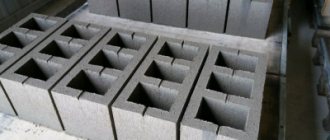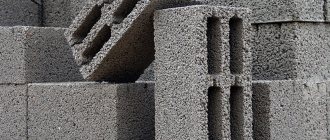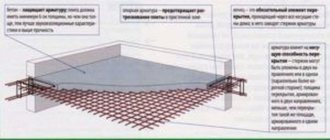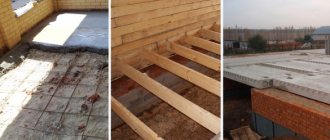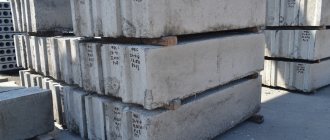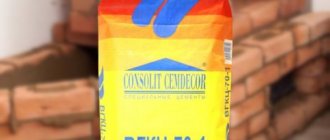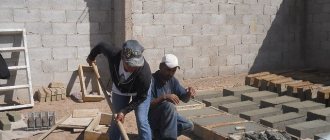For the construction of residential buildings, cinder blocks are often used - a lightweight and affordable material that can be made independently at home.
Cinder blocks can be solid, the structure of which contains a large number of solid particles, or hollow.
Such a stone has voids, due to which its weight is lighter and thermal conductivity increases. When constructing a building using hollow cinder blocks, you need to know its features.
What does the concept mean?
A hollow building material made from a mixture of slag and Portland cement has from 28 to 40% voids in its composition . During production, these voids are made as follows: after pouring the concrete solution into the molds, cone formers are lowered into them, which make holes that do not reach the end of the bottom of the block. When the product dries, it will have several holes.
Hollow cinder blocks are also called slotted, since in addition to round holes, slotted voids can be made in them.
The building material itself is successful in the construction of internal walls and partitions of residential buildings. Due to the reduction in the amount of solid particles in the composition, such raw materials have insignificant weight compared to solid blocks.
What are they and what are their differences?
There are several types of slotted cinder blocks:
- with two holes;
- with three holes;
- four-slit;
- 7-slit;
- with square two holes.
Cinder block with two holes:
With three holes:
4-slit cinder block:
7-slot:
With two square holes:
The listed cinder blocks differ in appearance and hole configuration. In some stones they are made in the form of a cone, with most of them facing up. In other stones, the holes look like long rectangular strips. Where the holes are round, there are more voids, and where the holes are rectangular, the voids occupy less volume of the stone.
Reference! In addition to light weight and good thermal insulation, cinder blocks have a good ability to insulate a room in noise and sound.
Requirements according to GOST
According to construction standards, there are requirements for hollow cinder blocks. They are regulated in the document GOST 6133-99. It is said here that slotted stone for construction is a wall block with through or non-through (with a bottom) vertical voids, which are obtained during the molding process. These voids give the products the necessary performance properties .
When selling a cinder block, its marking must contain the letters “PS”, which means hollow. For example, the designation of a stone will contain the following signs:
- K-stone;
- S, P, L, R – wall, partition, front silt;
- PS – hollow;
- length in centimeters;
- strength grade;
- frost resistance grade.
According to GOST requirements, the dimensions of the stone from the slag mixture must comply with the document. Deviation of length and width dimensions by +-3 mm, height by +-4 mm is allowed . External defects in excess of the permissible size standards are not allowed on the stone. Sinks on cinder block should not be deeper than 4 mm. Grease stains with a diameter of more than 10 mm on the surface of such a block are not allowed.
Permissible deviations
The geometric dimensions and shape of the blocks must comply with standard standards, but small parameters errors are allowed:
- length – 13 mm;
- width – 8 mm;
- height – 8 mm;
- Slot size – 5 mm.
Products with cracks in concrete are not acceptable, except for damage caused to the surface as a result of shrinkage. Their width is no more than 0.1 mm for heavy grades and 0.2 mm for light grades of concrete. Not only the size, but also the weight of the products is important. If it is less than standard, errors were made during manufacturing and voids formed inside the structure. The defect will negatively affect the strength of the block.
What kind of walls are they used for?
Hollow cinder block stone is used only for laying interior walls of a house or partitions .
This is due to its low strength and inability to withstand heavy loads. For the construction of external, main walls, which are the support for the floors, only solid stones are used.
For example, if the load-bearing walls of a house are built from hollow cinder blocks with 3 holes, they will not be able to support the load. Due to the fact that the hollowness of such stones is 28-40%, they do not have the proper strength .
Over time, when choosing this block for the construction of permanent walls, cracks may form on the surface of the masonry, and the wall itself will sag and be in disrepair.
Note! This material is just suitable for interior walls. There is no need to serve as the main support here, so a hollow block will fit in place. It is also good to build partitions from raw materials: special partition blocks of convenient sizes are even produced for this purpose.
Scope of application and comparison with other building blocks
Hollow block is popular in various fields of construction. In low-rise buildings it is used as a material for load-bearing walls and partitions. The hollow concrete block is intended for residential and technical premises, outbuildings, and garages. When constructing a strip foundation, the building material is used as permanent formwork. Reinforcement is placed in the voids and filled with concrete. The result is a monolithic structure. Other applications:
- creation of a protective casing when laying pipelines;
- erection of barriers in road construction;
- material for the construction of fences and fences;
- installation of ramps and bridges.
Ready-made concrete and reinforced concrete structures for foundation construction are of three types:
- solid FBS;
- solid with a cutout for FBV communications;
- hollow FBP.
The structures have standard dimensions and weight, and are made of heavy, dense (silicate) or light (porous) concrete. Solid blocks have a larger number of standard sizes. Products are produced in lengths of 780, 880 mm, and height of 280 mm. Their weight is less, so they are easier to use in private construction.
Each type of concrete block has advantages and disadvantages. Solid products provide maximum load-bearing capacity, can be used on various construction sites, and are suitable for all climatic zones. Their disadvantage is their significant weight and cost, which are not always justified when constructing low-rise buildings.
In addition to concrete blocks, aerated concrete, foam concrete and slag concrete products are used for the construction of strip foundations and pillars. They are small in size and easy to install by hand. The disadvantage of the materials is increased hygroscopicity. When using them, the costs and labor required to perform waterproofing increase. In terms of strength, cellular concrete is inferior to heavy and dense compositions.
Main characteristics
A hollow cinder block has several characteristics:
- frost resistance – from F15 to F50;
- weight – from 10.5 to 14 kg;
- walls of partitions between voids - at least 20 mm;
- compressive strength - from 35 to 150 kg/sq.cm;
- density according to GOST - 1650 kg/m3;
- strength grade - M-125, M-100, M-75, M-50, M-35;
- thermal conductivity - from 0.35 to 0.48 W/m °C.
We should also talk about the size of the hollow stone. The most common are 200x200x400 mm (20x20x40 cm), as well as 390x190x188 mm, 390x120x188 mm, 390x90x188 mm . The last two sizes are used for laying partitions, as they have a reduced width, due to which they do not “steal” space in the house.
How to correctly lay stone with voids?
Compared to laying solid blocks, the construction of walls made of hollow stone has several features:
First, pull the cord to make markings.- The laying is done after finding the highest point of the foundation.
- The solution is applied to the foundation, then a block is applied and its position is leveled with a mallet.
- The solution is immediately applied to the end parts of the block.
- If stones with slotted holes on the sides are used, then the solution must be applied to the ends of the strips.
- The stone is pressed tightly to the masonry with your hands.
- Each row must be checked by a tight cord or level.
Additionally, it is recommended to use a special arrangement: a device that allows you to create a gap between the stones for a mortar joint of a certain thickness. After installing the block, the order is removed and used when laying the next stone.
Read more about how to properly lay all types of cinder blocks here.
Pros and cons of use
The use of hollow cinder blocks has several advantages:
- light weight;
- low thermal conductivity;
- efficiency;
- presence of holes.
Due to the light weight, the load on the foundation will be minimal, and no equipment will be needed to lift the blocks onto the masonry. Voids retain heat in the room more easily; such a house will always have a comfortable temperature . In a separate article you can learn how to insulate a house with cinder blocks.
Due to the fact that the stone contains about 28-40% voids, the cost of its production is less, therefore, the final cost will be cheaper than that of a solid stone. The presence of holes will help to lay communications inside.
Among the disadvantages of this building material: it does not withstand too much physical stress , and also, due to the presence of holes, it does not allow you to properly hang anything on the wall.
Standards and markings of hollow concrete blocks
Hollow concrete blocks retain heat better.
Hollow foundation blocks (FBP) are one of three types of concrete blocks. The standard for their production is determined by GOST 13579-78. The building material is made from various types of concrete, and reinforcement is used for reinforcement. The geometric shape of the product is a parallelepiped, there are vertical holes in the lower part. The thickness of their walls is at least 100 mm. The notches do not reach the surface by 30 mm.
Product dimensions in mm:
- length – 2380 (indicated as 24 dm);
- width – 400, 500, 600;
- height – 580 (rounded to 6 dm).
The marking of products indicates their type, dimensions (length, width, height) in decimeters, type of concrete and GOST.
Among the types of concrete used:
- T – heavy;
- P – porous with expanded clay filling;
- C – silicate.
Example of marking: FBP 24.4.6-S GOST 13579-78. The foundation block is hollow, length 2380 mm, width 400 mm, height 580 mm. Material – dense silicate concrete.
The marking is applied on the side and can be supplemented with the date of manufacture and the name of the manufacturer's company.
Average prices
Hollow stone is sold on the same basis as solid blocks, so finding it will not be difficult.
On average, 1 stone measuring 390x190x188 mm with 4 slots will cost 41 rubles , and a cubic meter of such material will cost 2950 rubles.
For a partition block measuring 390x120x188 mm you need to pay 36 rubles, and for a cube of material - 4500 rubles.
If you buy a 7-slot cinder block for walls with dimensions of 390x190x188 mm, then for a joke they will ask on average 47 rubles, and for a cube - 3300 rubles.
